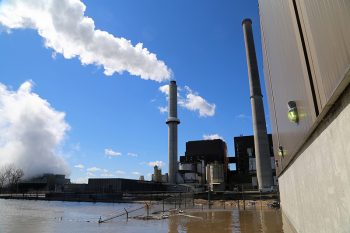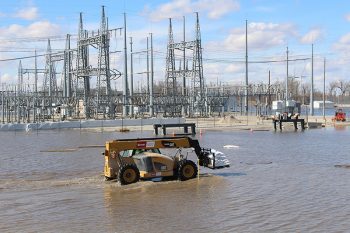Recovering from a natural disaster

Instead of getting to know her new co-workers and other typical first-week-on-the-job activities, Firuza Jimenez spent her first days at OPPD going through a crash course in how the utility – and especially the Corporate Accounting team – operates amid a natural disaster.

A massive storm struck the Midwest in the second full week of March. A bomb cyclone unleashed blizzard conditions along with heavy rainfall. The frozen ground couldn’t absorb the mixture, resulting in record flooding in Nebraska and other states. Ice dams and fast fast-moving runoff destroyed bridges, levees and roads and left four Nebraskans dead. The Missouri River, as well as those rivers below the dam system, saw massive flooding and threatened OPPD’s largest generating station.
By the third day, Missouri River water levels had risen so dramatically that the utility decided to take its Nebraska City Station (NCS) unit 2 offline that night to protect the plant. Equipment was moved to higher ground where possible and only a handful of essential employees remained at the plant to monitor the shutdown. Unit 1 at NCS was already offline for a planned maintenance outage.
“It was like drinking from the firehose,” Jimenez said of her first week at OPPD. “There was a lot of work to do to identify the impacted sites so we could provide to those areas.”
Jimenez and other employees in her department had to account for all the costs and time spent on various projects so they could “build the case for how much damage we might have, along with the costs to protect our critical sites,” she said.
That kind of documentation is required when seeking federal assistance in the wake of a natural disaster.
Shifting gears
Fortunately for OPPD, the planned maintenance outage meant extra workers and contractors were on site.

They quickly shifted gears and went to work filling sandbags and executing other protection measures to save the plant. There was worry that the NCS substation, just west of the plant, would be flooded, which would have caused transmission issues.
The flood destroyed the Spencer Dam and plant on the Niobrara River. Hundreds of miles of highways were damaged, as were thousands of acres of farm land.
It was quickly evident Nebraska was facing a massive natural disaster.
Most of the damage was in eastern Nebraska, though the entire state received a major disaster declaration on March 21, 2019. That declaration meant the state was eligible for federal assistance, coordinated by the Federal Emergency Management Agency (FEMA). The damage to the state was later estimated at $2.6 billion.
Meticulous documentation
OPPD’s corporate accountants knew from experience that OPPD would need to keep meticulous records to be eligible for federal relief money. The utility had to document every piece of damaged equipment and infrastructure – from a breeched levee to downed power lines – and all the work done as part of the recovery process.
When seeking federal reimbursement, entities like OPPD must meet FEMA requirements and provide supporting details and documents. Areas of damage must be tied to specific GPS (global positioning system) points.

For example, sandbags were widely used for barriers during the flood.
“We didn’t just have to order the sand and fill the bags for the barriers,” said Jim Karnik, manager of Asset Accounting at OPPD. “For cost recovery, the federal rules require that we identify where all the sand was placed through GPS coordinates, what the dimensions were, and the approximate amount of sand used. Then we had to show where we purchased it from and make sure to follow the environmental requirements for disposal.”
The same holds true for damaged equipment and cleanup work. Entities seeking assistance must answer any questions raised by FEMA or other government agencies about specific project details. Photos and news accounts that can corroborate the damage are helpful.
“If something was damaged, were there historical ramifications, do you have the long-term maintenance records?” said Jimenez, citing some examples of support needed for FEMA. “Do you have any pre-damage pictures? Did the contractor have a permit to burn the sticks and limbs they burned for us? What are the GPS coordinates of the burn site? FEMA wants the beginning and end for every item.”
A lengthy process
More than four years after the historic 2019 flood, OPPD is expecting its last partial reimbursement from FEMA at some point this year or early next year.

“We are going through the final steps with FEMA and NEMA (Nebraska Emergency Management Agency) to review everything and disperse the money,” Jimenez said.
The flood of 2019 is one of four natural disasters that Karnik’s team worked on in recent years. The others: the COVID-19 pandemic, the July 2021 storm and the December 2021 wind storm.
When a natural disaster occurs, employees typically spend several hundred hours on documentation and coordination with federal and state agencies, Karnik said. In the case of the 2019 flood, that work took thousands of hours.
Declaring a disaster
Disaster declarations are made at the county level first. The county must meet a damage threshold, based on its population, to be eligible for assistance, said Tonya Ngotel, OPPD’s manager of Emergency Preparedness. For example, the minimum amount of damage needed for a declaration for Douglas County, population 584,526, is about $2.5 million. In much smaller Richardson County, with a population of 7,871 people, the minimum is $35,000.

Electric utilities – with all their poles, lines and other infrastructure – often take the brunt of damage caused by natural disasters. That damage is often highly visible and expensive. For the early documentation of damage – which is required to get approval – the cost estimates can be challenging to provide. Accounting employees must coordinate with operations personnel, who are already busy working to ensure customers get their power back as soon and as safely as possible.
When a natural disaster happens, Karnik’s team works with Ngotel’s cost recovery team to get preliminary estimates in as early as possible.
From the county level, the process goes to the state level, where the governor can make a disaster declaration. If the cost exceeds what the state and affected local governments can handle, the governor can ask FEMA for help and request a Preliminary Damage Assessment.
The assessment will evaluate the damaged area to determine the extent of the disaster. The assessment also evaluates the impact on individuals and public facilities, and the types of federal assistance that may be needed. After that is done, the governor can submit a declaration request to the president through the FEMA regional office.
Receiving reimbursement
Typically, federal reimbursement after a major disaster declaration covers 75% of the total eligible costs. But in May 2021, President Joe Biden made additional disaster assistance available to the state for the flooding. The federal funding level for public assistance projects was increased to 90% of the total eligible costs.
After the initial federal disaster was declared, Karnik and other members of OPPD met weekly with FEMA and NEMA for more than two years. OPPD worked with those agencies to identify 27 projects that would have to go through the documentation and approval process. All but one of those 2019 projects have been closed out.
So far, $4.4 million has been reimbursed to OPPD for the 2019 flood. An additional $6 million expected in the final reimbursements. OPPD received $4 million in compensation from insurance, Karnik said.
Jimenez and Karnik worked on flood-related matters for two years, as did OPPD’s former Emergency Preparedness manager and two contractors.
Storm vs. natural disaster
When storms strike, the process generally takes much less time, Karnik said.
“Floods are so widespread and the damage isn’t as evident right away as with a tornado or snowstorm,” Karnik said. “You have to wait for the water to recede and there is so much more documentation. By comparison, we’ve almost closed out both of the 2021 storms already.”
OPPD received more than $15 million in reimbursement from those 2021 storms. The utility expects to receive another $7 million in the next year.
The flood and other natural disasters have kept Jimenez busy ever since that first week on the job.
“OPPD works to maximize the cost recovery in all FEMA declared disasters,” she said. “It’s important to our customer-owners that we do so. The process with FEMA and NEMA requires a lot of work, but that makes sense, as these are U.S. tax dollars being used. FEMA and NEMA have to ensure all the rules are followed.”

Jason Kuiper joined OPPD as a communications specialist in 2015. He is a former staff writer and reporter at the Omaha World-Herald, where he covered a wide range of topics but spent the majority of his career covering crime. He is a graduate of the University of Nebraska at Omaha and has also appeared in several true crime documentary shows. In his free time he enjoys cooking, spending time with his wife and three children, and reading crime novels.
View all posts by Jason Kuiper >







